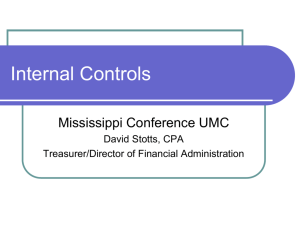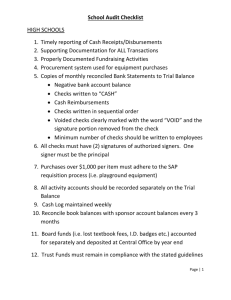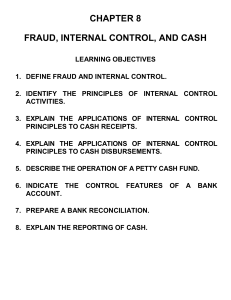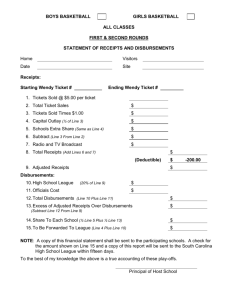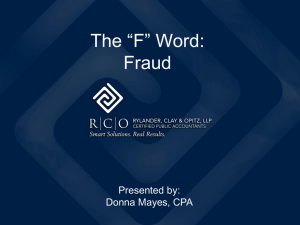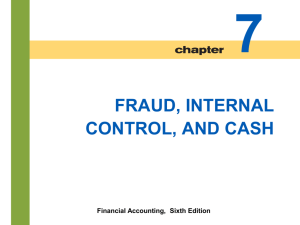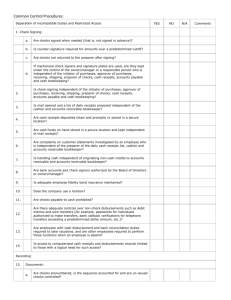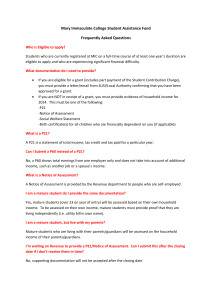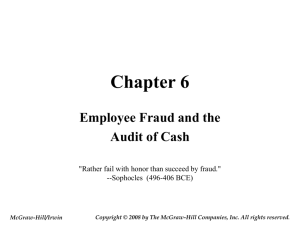Basic Internal Controls for All United Methodist Churches
advertisement
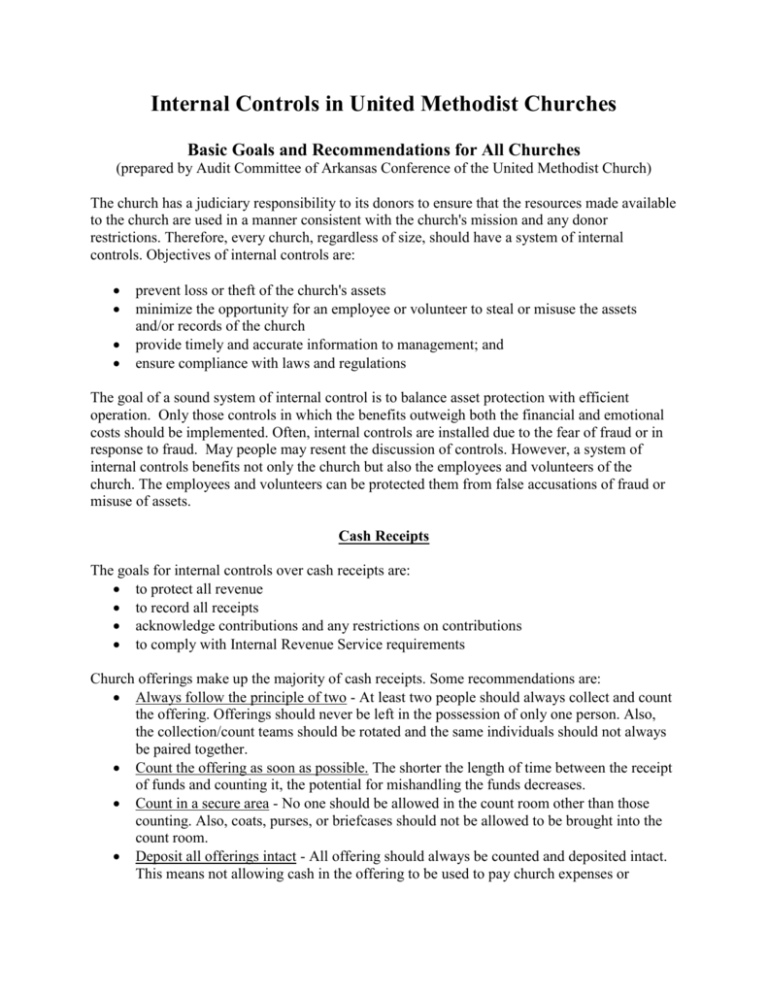
Internal Controls in United Methodist Churches Basic Goals and Recommendations for All Churches (prepared by Audit Committee of Arkansas Conference of the United Methodist Church) The church has a judiciary responsibility to its donors to ensure that the resources made available to the church are used in a manner consistent with the church's mission and any donor restrictions. Therefore, every church, regardless of size, should have a system of internal controls. Objectives of internal controls are: prevent loss or theft of the church's assets minimize the opportunity for an employee or volunteer to steal or misuse the assets and/or records of the church provide timely and accurate information to management; and ensure compliance with laws and regulations The goal of a sound system of internal control is to balance asset protection with efficient operation. Only those controls in which the benefits outweigh both the financial and emotional costs should be implemented. Often, internal controls are installed due to the fear of fraud or in response to fraud. May people may resent the discussion of controls. However, a system of internal controls benefits not only the church but also the employees and volunteers of the church. The employees and volunteers can be protected them from false accusations of fraud or misuse of assets. Cash Receipts The goals for internal controls over cash receipts are: to protect all revenue to record all receipts acknowledge contributions and any restrictions on contributions to comply with Internal Revenue Service requirements Church offerings make up the majority of cash receipts. Some recommendations are: Always follow the principle of two - At least two people should always collect and count the offering. Offerings should never be left in the possession of only one person. Also, the collection/count teams should be rotated and the same individuals should not always be paired together. Count the offering as soon as possible. The shorter the length of time between the receipt of funds and counting it, the potential for mishandling the funds decreases. Count in a secure area - No one should be allowed in the count room other than those counting. Also, coats, purses, or briefcases should not be allowed to be brought into the count room. Deposit all offerings intact - All offering should always be counted and deposited intact. This means not allowing cash in the offering to be used to pay church expenses or exchanged for other cash or a check. An unidentified variance could occur if offerings are not deposited intact. Use a restrictive endorsement - Before or while counting, a restrictive endorsement should be stamped on the back of all checks. Verify amounts on offering envelopes - When the count team removes contents from offering envelopes, the amount written on the envelope should be compared to the contents. Any differences should be noted on the envelopes and initialed by the count team. Provide a secure location when offerings are stored on church property - Again, follow the principle of two. No one person should have access to the collections at anytime. This can be accomplished by placing the offerings in a locked bag before placing them in a lock box. Use count sheets Segregate duties - Someone separate from the count team should record individual gifts in donor records. Also, count sheets should be reconciled regularly to deposits by someone other than the person making the deposit. Cash Disbursement The goals for internal controls over cash disbursements are: to ensure disbursements are made only upon proper authorization. to ensure expenditures are for valid business purposes that they are properly recorded in church's records. Again, segregation of duties is important. One person should not handle a transaction from beginning (authorization) to end (reconciliation). An individual should not have an opportunity to make an accounting error, whether intentional or unintentional, and also conceal it. Generally, the same person should not authorize, process, sign the check, record and reconcile a transaction. Expenditures should be controlled by an approved budget, should be based on approved purchase orders or requisitions and receipt of goods and services should be verified before the payment of an invoice. Payments of customer statements should generally be avoided, however, periodic statements received from vendors should be reconciled to underlying invoices received from the vendor. All disbursement checks should require two authorized signatures. Checks should be submitted for signatures with all properly approved original invoices or receipts attached to each individual check. Authorized signers should never sign any checks without reviewing the check and the attached supporting documentation information. The church financial secretary or bookkeeper should not be given the authority to sign checks. Credit Card Charges Absolutely, under no circumstances should church credit cards be used for personal reasons. Certain church staff members may be issued a church credit card. They will be personally responsible for all charges made on that card. Additional cards may be available for church members to use. These cards will need to be signed in/out in the financial secretary's office. Receipts should be given to the financial secretary in order to support the charges on the bill and, if required, a payment request form should also accompany the receipt. Reconciliations Sound decisions are difficult to make if the information in the financial reports cannot be relied upon. Therefore, adequate steps should be taken to confirm the accuracy of the balances shown in checking accounts, and all other financial accounts. Balances of these accounts should be compared to detailed reports of any subsidiary ledgers. Differences should be documented using reconciling items. Reconciliations should be completed monthly. All accounts should be reconciled to a subsidiary ledger on a regular and timely basis. The person responsible for reconciling the bank accounts should not also authorize transactions. Other Often, the most valuable property the church owns is its building and facilities. The church may also own other properties like a parsonage or youth center. The church often owns personal property like office equipment, organ, piano, audio-visual equipment, and vehicles. Controls protecting such assets should ensure that the property is catalogued, present, and adequately insured with up to date coverage. In addition, purchases or dispositions should be properly authorized. This can be accomplished by instituting a policy or policies regarding use of the facilities - wedding policy, building use policy, and van policy. In many small churches, the most important component of internal control is the control environment which is influenced by the governing board and management. Often, it is the minister who is the driving force of the control environment. The minister's attitude with respect to internal controls has a significant impact on the church's control environment. Most church members want to believe that anyone connected with their church is trustworthy and in such arena of trust let their guard down, thus, making the church vulnerable. Even though no system is foolproof and it is difficult to put a value on internal controls, consider whether there is a benefit to the church to: remove temptation for misappropriation prevent clouds of suspicion from developing over heads of honest staff members improve likelihood of errors, both intentional and unintentional, being discovered reduce risk of having to confront a member or employee who has taken funds reduce chance of having to tell congregation that their contributions are lost.
